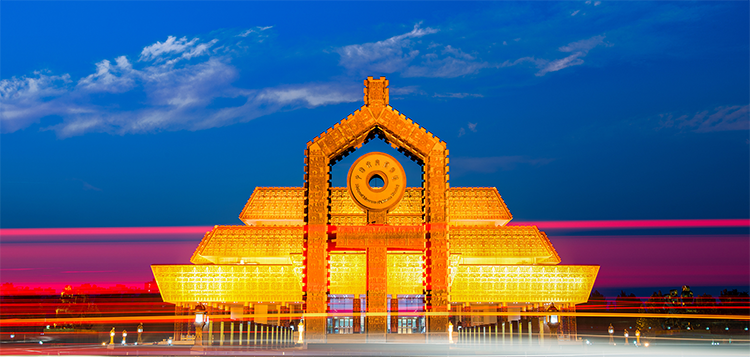Discover Chinese Calligraphy at Anyang’s Chinese Characters Museum
Introduction: Entering the Source of Chinese Writing
On the plains of Anyang in Henan — the cradle of early Chinese civilization — stands a unique institution: the Chinese Characters Museum. More than a building, it is a three-dimensional encyclopedia of Hanzi, tracing the evolution of Chinese characters from oracle bone inscriptions to today’s standard forms. Step inside to touch the genetic code of Chinese civilization and witness how symbols that once recorded divination have become the world’s longest-continuously used writing system.
1. Museum’s core features and positioning
The Chinese Characters Museum is China’s only national first-class museum dedicated entirely to writing, widely praised as a shrine of character culture. It functions not only as a public window onto the history of Chinese writing but also as a major research center for oracle bones, bronze inscriptions, and other precious artifacts. Built in an Anyang Yinxu inspired style and combined with modern display technology, the museum brings ancient script to life.
2. Architecture and history: a ‘yong’ character layout in Yin–Shang style
The building itself is a work of art. The main plan adopts the shape of the Chinese character “墉” (yong), evoking the thick, protective walls of ancient cities and symbolizing the durability and continuity of written heritage. The façade uses a bronze palette and is accented with oracle bone motifs, creating the impression of a text-shaped fortress that bridges eras.
The museum opened in 2009, and its location in Anyang is deliberate — this is the site of Yinxu, the birthplace of oracle bone inscriptions. As an extension of the Yinxu World Heritage Site, the museum fills the gap for a national institution focused on writing and has become an essential base for global Hanzi research.
3. Treasures and core exhibits
(1) Yinxu oracle bones: the “childhood” of Chinese characters
The museum preserves many oracle bone inscriptions excavated from Yinxu, including records of Shang dynasty divinations. These incisions on turtle plastrons and animal bones represent the earliest mature forms of Chinese writing. Through them, visitors can see how people three thousand years ago used characters to communicate with the spirit world.
(2) Bronze inscriptions: the fusion of rulership and script
Bronze inscriptions from the Western Zhou period are another highlight. Replicas of famous ding vessels such as the Mao Gong Ding and the Da Yu Ding display the solemn and ornate style of jinwen (bronze script). These inscriptions are historical records and early masterpieces of calligraphic art.
(3) Minority scripts: a tapestry of cultural diversity
Beyond Hanzi, the museum exhibits Tibetan, Mongolian, Uyghur, and other minority scripts, showcasing the multilingual and multicultural dimensions of China’s writing heritage.

4. Exhibition experience: from oracle bones to modern Hanzi
The permanent exhibition “History of Chinese Characters” is the museum’s backbone, arranged chronologically:
– Oracle bone inscriptions and bronze script (Shang–Zhou)
– Small seal script and clerical script (Qin–Han unification)
– Regular script and running script (Wei–Jin to Tang–Song)
– Printing and modern Chinese characters (Song–Yuan to present)
Displays are more than static panels: interactive screens and AR installations let visitors try writing oracle characters, experience movable-type printing, and explore the visual evolution of strokes and forms.
5. Atmosphere and environment: an immersive cultural journey
The museum attracts culture lovers, school groups, and families, offering a respectful yet exploratory atmosphere. Soft lighting and clear circulation ensure artifacts are shown in optimal conditions. The central courtyard’s “Text Corridor,” a light-and-shadow installation of calligraphic masterpieces, is a popular photo spot.
6. Practical guide: planning your visit
Recommended visit durations:
– Short (1.5 hours): Focus on oracle bones, bronze inscriptions, and the interactive zone.
– In-depth (3+ hours): Complete the permanent exhibition and join calligraphy workshops.
Who should visit:
– Culture enthusiasts: deep insight into Hanzi development and calligraphy.
– Families: hands-on areas are ideal for children.
– Scholars: rich resources of oracle bone and bronze inscriptions.
Combined itinerary suggestion:
– Morning: Chinese Characters Museum
– Afternoon: Yinxu archaeological site (about 6 km, 15 minutes by taxi)

7. Useful tips
Tours and guides:
– Audio guide: Chinese and English versions available, rental around 20 RMB.
– Live guided tours: regular Chinese sessions; English guided tours require advance booking.
Tickets and entry:
– Admission: free (ticket issued upon presenting ID).
– Reservations: book in advance via the official WeChat account; foreign visitors exchange passport for entry ticket on arrival.
Transport:
– Metro/bus: no direct subway; take local buses to “Characters Museum” stop.
– Taxi/car: search “Chinese Characters Museum” on navigation apps; on-site parking available (about 5 RMB/hour).
Facilities and services:
– Wi‑Fi: free museum-wide coverage.
– Dining: an on-site café and nearby local restaurants.
– Accessibility: ramps and wheelchair access throughout; stroller-friendly routes.
8. Local insider tips: hidden experiences
– Don’t miss the third-floor calligraphy practice area, where you can try brush-copying ancient characters for free.
– Best photo spot: the Text Corridor in the central courtyard—magical at dusk.
– Avoid disappointment: the museum is closed on Mondays; try to avoid major holiday crowds.
Conclusion: A dialogue with Hanzi
The Chinese Characters Museum is more than a museum — it’s a conversation with the source of Chinese civilization. Every stroke carries ancient wisdom and every artifact tells a millennia-old story. If you’re curious about Chinese culture, this Anyang stop is essential.


